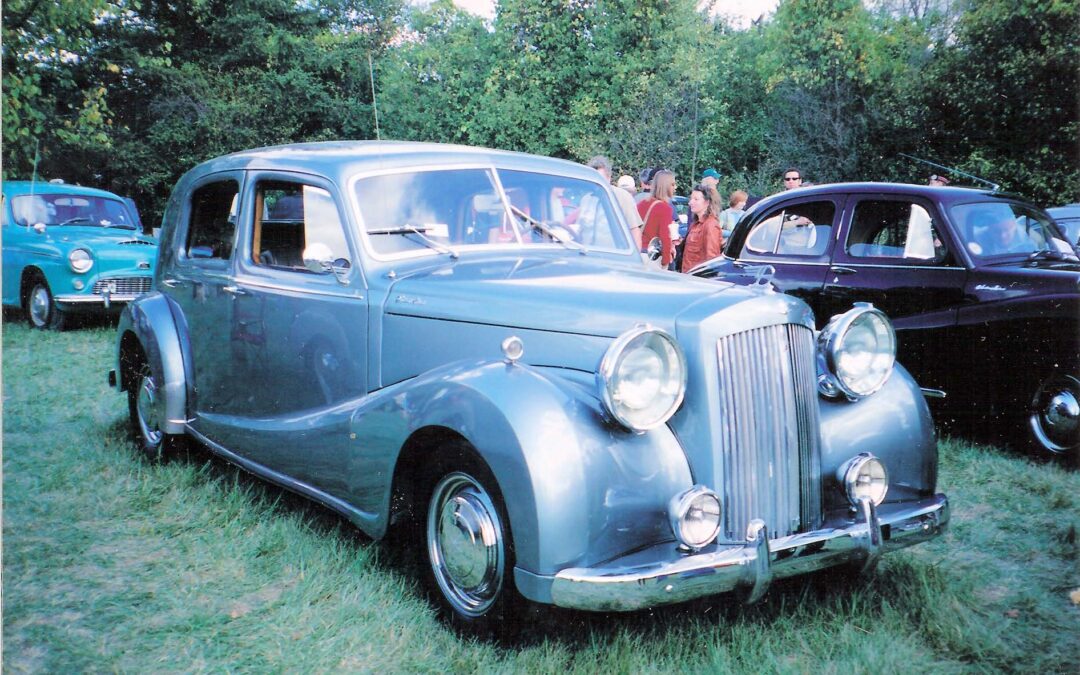Austin Sheerline – Bill Vance
English Austins have usually been thought of by North Americans as small, economy cars, usually with four cylinder engines. The first one to gain real popularity was the A40, a pleasant little four passenger sedan that provided adequate performance and good fuel economy.
It began arriving in quantity in 1948, and with the pent-up demand for new cars that followed the Second World War it did fairly well for a few years. It was followed by upgraded models such as the A50 and A55 and even some six cylinder models.
The A40 et al, and the tiny American Austin/Bantam, a clone of the English Austin Seven that was produced in Butler, Pennsylvania during the 1930s, consolidated the perception that Austins were small. Thus it was a surprise when the Austin Motor Co. introduced a car that abandoned the economy car persona and moved into the luxury field: the Austin Sheerline.
The Sheerline was conceived during the Second World War by Austin head Leonard Lord who drove a Bentley as his personal car. He wanted to take Austin beyond its work-a-day image and expand into the luxury class.
He envisioned a kind of “poor man’s Bentley” that would complete with the luxury of Bentley and Rolls-Royce at a price low enough to escape the English sales tax that doubled for cars over 1,000 pounds sterling. It was not intended to be chauffeur-driven, but to appeal to the owner who wanted to drive his own car, who couldn’t afford a Rolls or Bentley, or who just wanted to avoid the ostentation.
The Austin A110 Sheerline arrived in 1947 with a 3.5 litre (3460 cc), overhead valve, inline six cylinder 110 horsepower engine that evolved from a pre-war Austin truck. It was soon realized that more power was required, so after a handful of A110s were produced, the six was increased to four litres (3995 cc) and 125 horsepower to become the A125 Sheerline. There was also a more luxurious Princess companion model bodied by Austin’s recently acquired coachbuilder Vanden Plas.
The Sheerline was a body-on-frame sedan with a 3029 mm (119.25 in.) wheelbase and overall length of 4877 mm (192 in.), about the size of a 1948 Chevrolet. It stood a towering 1702 mm (67 in.) tall.
The Sheerline’s technology was quite conventional. Suspension was independent by A-arms and coil springs in front, while at the rear were longitudinal semi-elliptic springs and a solid axle.
The drum brakes were hydraulic on all four wheels, and power went to the rear wheels through a column-shifted, four speed transmission with synchromesh on the top three. A welcome feature for North Americans was a built-in hydraulic jack at each wheel to facilitate wheel changing. Like other English cars it had a 12-volt electrical system when American cars were still struggling along with an anaemic six volts.
Styling followed the British “razor edge” motif with a multi-bar, vertical grille topped by Austin’s “Flying A” hood ornament. There were prominent front fenders and free-standing Lucas P100 headlamps so large that jesters said turning them sideways increased top speed by several miles per hour!
The interior was typical English luxury with leather upholstery and two fold-down armrests in the front seats. Underfoot were thick Wilton carpets, and the rich wood trim on the instrument panel and door caps reflected its quality finish. Radio and heater were standard and the steering column was telescopically adjustable. The only jarring notes were the rectangular instruments which seemed out of place in a luxury car.
Sheerlines were exported to several countries, including the United States. Some probably reached Canada, although the numbers were likely small.
Its performance ran into stiff competition in North America, the land of the big car. The 125 horsepower six took over 20 seconds to accelerate the 1928 kg (4250 lb) sedan to 97 km/h (60 mph), in spite of a stump-pulling 4.25:1 rear axle ratio. Top speed was only some 132 km/h (82 mph). This meant that it could be easily outrun by such lowly American cars as Chevrolets and Fords.
A contest between an Oldsmobile 88 or Cadillac, both of which cost less than the Austin’s close to $6,000, would have been downright embarrassing.
Not surprisingly the Austin Sheerline found very few buyers in North America. Although it was large and luxurious with a certain old world charm, wood, leather and razor edge styling were not enough to compete with the big American car’s V-8 smoothness, performance and price.
Sheerline production carried on until 1954 without significant change during which less than 8,000 sedans were built. There were also limited production limousine, ambulance and hearse versions. The A135 Princess continued for a few years longer, but like the Sheerline it did not make an impact in North America.

